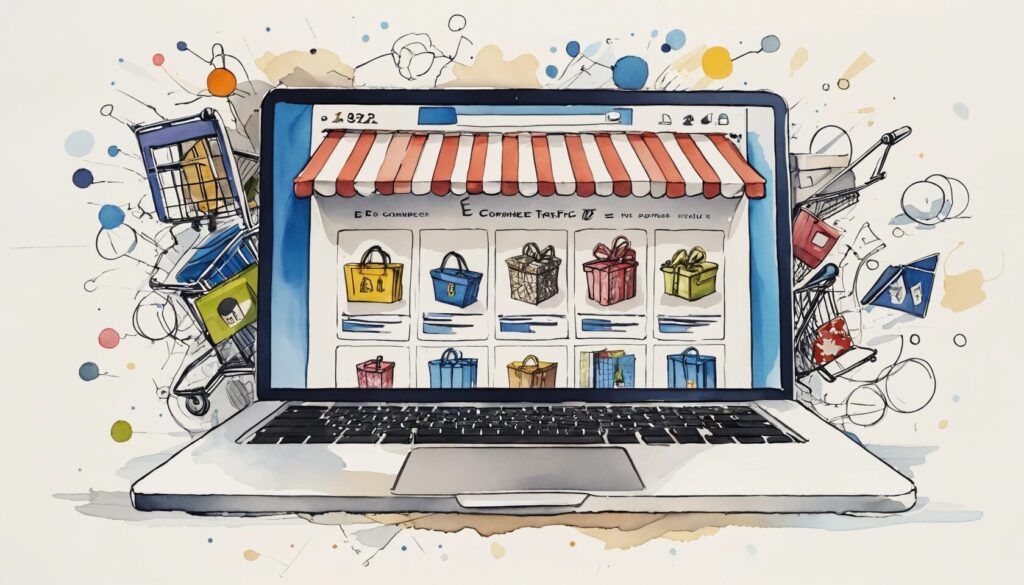How to Skyrocket Your Ecommerce Traffic (Without Losing Your Mind)
So, you’ve built a sleek, modern online store filled with must-have products. Great! But if your visitor count is lower than a forgotten MySpace page, you’ve got a problem. The internet is a crowded marketplace, and standing out requires more than just wishful thinking. If you want to increase ecommerce traffic, you need a strategy that blends ecommerce SEO strategies, content marketing for ecommerce, and mobile optimization for ecommerce. The good news? You don’t need a magic wand—just a solid plan. Let’s break it down.
Ecommerce SEO: Because Google Won’t Rank You Out of Pity
- Optimize your meta tags and descriptions with high-impact keywords.
- Improve site speed and mobile responsiveness for a frictionless experience.
- Use structured data to make your products more visible in search results.
- Earn authoritative backlinks to boost your store’s credibility.
If your online store isn’t optimized for search engines, it’s practically invisible. Google doesn’t rank websites based on effort—it ranks them based on relevance and authority. Start by fine-tuning your meta tags. Titles, descriptions, and alt texts should include the keywords your customers are searching for.
Next, let’s talk about speed. A slow site is a one-way ticket to high bounce rates. Compress images, use browser caching, and ensure mobile responsiveness. Nobody wants to pinch and zoom just to read your product descriptions.
Structured data (also known as schema markup) helps search engines understand your content better. When done right, it enhances your listings with rich snippets—think star ratings, pricing, and stock availability—which can increase click-through rates.
Finally, backlinks from reputable sites tell search engines that your store is trustworthy. Guest blogging, digital PR, and influencer partnerships are great ways to earn these credibility-boosting links.
Content Marketing: Give Customers a Reason to Stick Around
- Create blog posts that answer customer questions and solve their problems.
- Incorporate engaging formats like videos, infographics, and interactive guides.
- Encourage user-generated content (UGC) to build trust and credibility.
Let’s be real—nobody wakes up thinking, “I can’t wait to read another product description today.” That’s where content marketing for ecommerce comes in. A strategically crafted blog post or video can attract potential buyers long before they’re ready to purchase.
Write articles that genuinely help your audience. A guide titled “How to Choose the Perfect Running Shoes” is far more useful (and SEO-friendly) than a product page stuffed with technical jargon.
Mix things up with different formats. Videos, infographics, and interactive elements can keep visitors engaged longer. A well-placed tutorial video can do more to convert buyers than a thousand words of text.
Finally, leverage your existing customers. Encourage them to share photos and testimonials. User-generated content builds trust, and trust leads to sales.
Paid Advertising: Because Sometimes You Need to Buy Attention
- Run highly targeted Google Shopping ads to capture high-intent buyers.
- Use retargeting ads to bring back visitors who abandoned their carts.
- Test different ad creatives and optimize for better conversion rates.
Organic traffic is fantastic, but sometimes you need a little push. That’s where paid ads come in. Google Shopping ads place your products right in front of potential buyers, increasing visibility and click-through rates.
Retargeting ads are another powerful tool. If a potential customer visited your store but didn’t buy, a well-timed ad can remind them of what they’re missing. Sweeten the deal with a limited-time offer to nudge them over the edge.
Don’t just set and forget your ads. A/B test different headlines, images, and calls-to-action to see what resonates with your audience.
Social Media: More Than Just Cat Videos
- Engage with your followers using interactive content and live videos.
- Collaborate with influencers to expand your brand’s reach.
- Use shoppable posts to make purchasing effortless.
Social media isn’t just for memes—it’s a goldmine for ecommerce brands. Engage your audience with polls, Q&A sessions, and live product demos. The more interactive your content, the more likely it is to be shared.
Influencer marketing isn’t just for fashion brands. Partnering with micro-influencers can expose your products to highly engaged audiences who trust their recommendations.
Shoppable posts on Instagram and Facebook allow users to buy directly from their feeds, reducing friction and boosting conversions.
Mobile Optimization: Because Nobody Likes Pinching and Zooming
- Ensure a seamless mobile experience with responsive design.
- Improve load times by compressing images and minimizing unnecessary scripts.
- Offer mobile-friendly checkout options like one-click payments.
With mobile shoppers making up a massive chunk of online sales, having a poorly optimized mobile site is like slamming the door in their faces. A responsive design ensures that your store looks great on any screen size.
Speed matters. A slow-loading site leads to abandoned carts. Compress images, minimize scripts, and use caching to keep things running smoothly.
Most importantly, make checkout as painless as possible. Mobile users love fast, frictionless transactions. Offering one-click payment options like Apple Pay or Google Pay can significantly reduce cart abandonment.
Final Thoughts: Time to Turn Traffic into Sales
Increasing ecommerce traffic isn’t about luck—it’s about strategy. By focusing on ecommerce SEO strategies, content marketing for ecommerce, mobile optimization for ecommerce, social media engagement, and targeted paid ads, you can steadily boost online store sales. The key? Stay consistent, keep testing, and never stop optimizing. Your future customers are out there—you just need to get in front of them.
